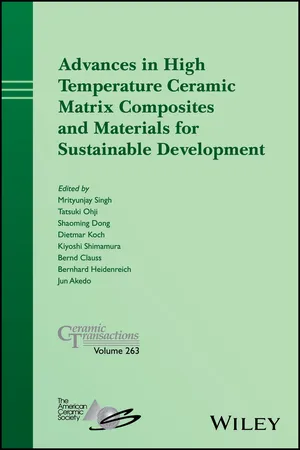
Advances in High Temperature Ceramic Matrix Composites and Materials for Sustainable Development
- English
- ePUB (mobile friendly)
- Available on iOS & Android
Advances in High Temperature Ceramic Matrix Composites and Materials for Sustainable Development
About this book
Global population growth and tremendous economic development has brought us to the crossroads of long-term sustainability and risk of irreversible changes in the ecosystem. Energy efficient and ecofriendly technologies and systems are critically needed for further growth and sustainable development. While ceramic matrix composites were originally developed to overcome problems associated with the brittle nature of monolithic ceramics, today the composites can be tailored for customized purposes and offer energy efficient and ecofriendly applications, including aerospace, ground transportation, and power generation systems. The 9th International Conference on High Temperature Ceramic Matrix Composites (HTCMC 9) was held in Toronto, Canada, June 26-30, 2016 to discuss challenges and opportunities in manufacturing, commercialization, and applications for these important material systems.
The Global Forum on Advanced Materials and Technologies for Sustainable Development (GFMAT 2016) was held in conjunction with HTCMC 9 to address key issues, challenges, and opportunities in a variety of advanced materials and technologies that are critically needed for sustainable societal development.
This Ceramic Transactions volume contains a collection of peer reviewed papers from the 16 below symposia that were submitted from these two conferences
- Design and Development of Advanced Ceramic Fibers, Interfaces, and Interphases in Composites- A Symposium in Honor of Professor Roger Naslain
- Innovative Design, Advanced Processing, and Manufacturing Technologies
- Materials for Extreme Environments: Ultrahigh Temperature Ceramics (UHTCs) and Nano-laminated Ternary Carbides and Nitrides (MAX Phases)
- Polymer Derived Ceramics and Composites
- Advanced Thermal and Environmental Barrier Coatings: Processing, Properties, and Applications
- Thermomechanical Behavior and Performance of Composites
- Ceramic Integration and Additive Manufacturing Technologies
- Component Testing and Evaluation of Composites
- CMC Applications in Transportation and Industrial Systems
- Powder Processing Innovation and Technologies for Advanced Materials and Sustainable Development
- Novel, Green, and Strategic Processing and Manufacturing Technologies
- Ceramics for Sustainable Infrastructure: Geopolymers and Sustainable Composites
- Advanced Materials, Technologies, and Devices for Electro-optical and Medical Applications
- Porous Ceramics for Advanced Applications Through Innovative Processing
- Multifunctional Coatings for Sustainable Energy and Environmental Applications
Frequently asked questions
- Essential is ideal for learners and professionals who enjoy exploring a wide range of subjects. Access the Essential Library with 800,000+ trusted titles and best-sellers across business, personal growth, and the humanities. Includes unlimited reading time and Standard Read Aloud voice.
- Complete: Perfect for advanced learners and researchers needing full, unrestricted access. Unlock 1.4M+ books across hundreds of subjects, including academic and specialized titles. The Complete Plan also includes advanced features like Premium Read Aloud and Research Assistant.
Please note we cannot support devices running on iOS 13 and Android 7 or earlier. Learn more about using the app.
Information
Thermomechanical
Behavior and Performance
of Composites
THERMAL ABLATION PERFORMANCE OF CF-HFB2 COMPOSITES WITH AND WITHOUT A C MATRIX DEPOSITED BY CVI
ABSTRACT
INTRODUCTION
EXPERIMENTAL
Table of contents
- Cover
- Title Page
- Copyright
- Preface
- Design and Development of Advanced Ceramic Fibers, Interfaces, and Interphases in Composites
- Innovative Design, Advanced Processing, and Manufacturing Technologies
- Advanced Thermal and Environmental Barrier Coatings
- Thermomechanical Behavior and Performance of Composites
- Component Testing and Applications of Composites
- Multifunctional Coatings for Sustainable Energy and Environmental Applications
- Ceramics for Sustainable Infrastructure
- Advanced Materials, Technologies, and Devices for Electro-Optical and Medical Applications
- EULA